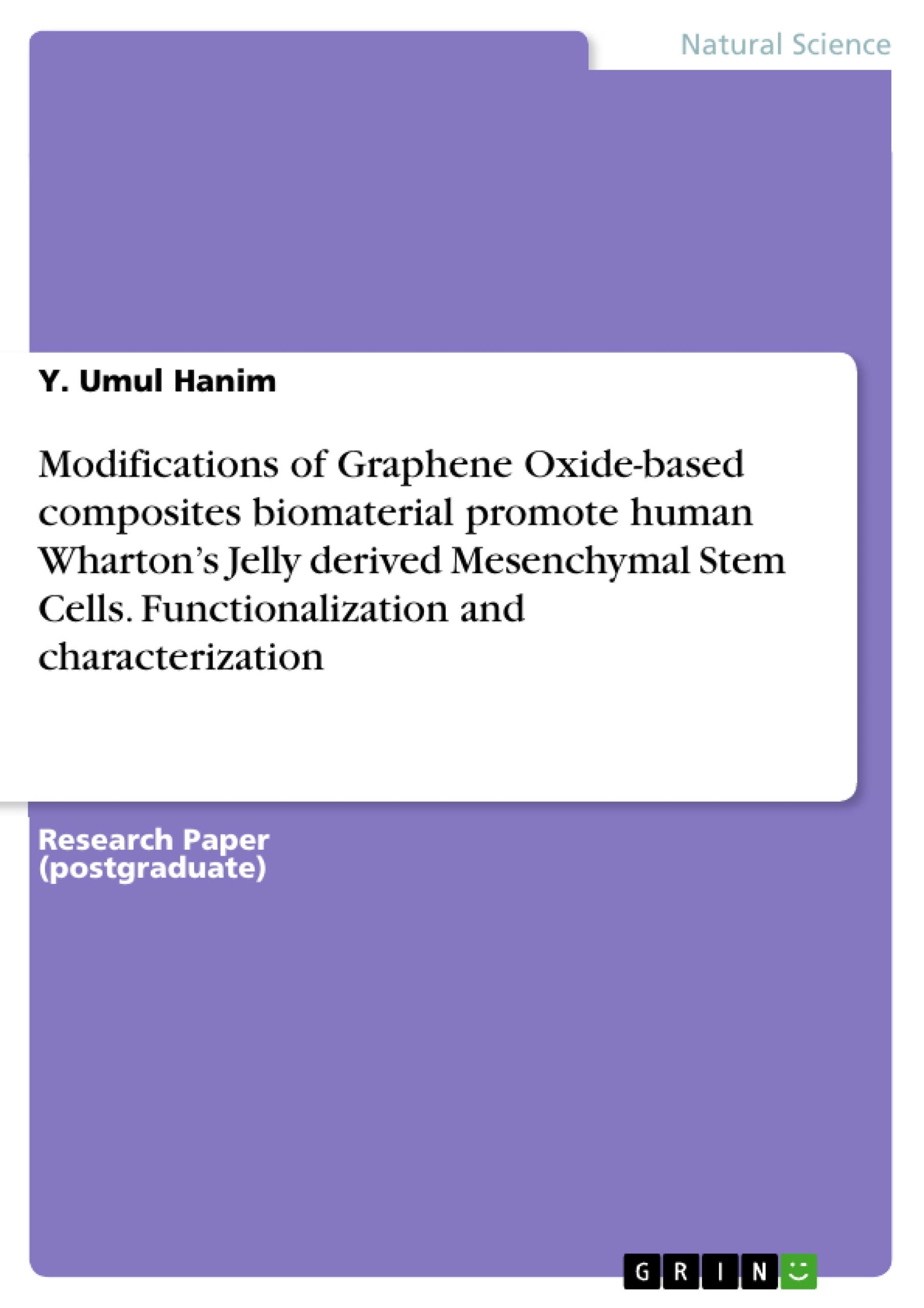The successful in developing a straightforward preparative route in biomaterial composite fabrication with the great promising Umbilical Cord Matrix derived mesenchymal stem cells (MSCs) known as Wharton’s Jelly also well known as fetal MSC.
WJMSC has been created a reliable modernist and briskest innovative research method especially in manipulation of Graphene Oxide (GO) as a new biomaterials loaded with an ample advantages in regard of synthetic materials that applicable for a replacement or regenerating a living system.
Bio-interface in mesenchymal stem cell certainly brighten the hope of all stripes scientist researchers in aspiration of biomaterial application whilst can impact the benefit in the fields of biomedical, biotechnology, bioengineering, pharmacology and biosensors yet the finding remain a number of challenges in the fast-growing field.
The purpose of this review, we enumerated the key aspect an earmark that will be focused on GO functionalization, and GO-WJMSC characterization, accordingly to GO-WJMSC application in enhanced the proliferation, and multipotency for a brighter future potential of GO-stem cells applicability.
Inhaltsverzeichnis (Table of Contents)
- INTRODUCTION
- Graphene Oxide
- Graphene Oxide properties
- Wharton's Jelly Derived Mesenchymal Stem Cell
- GO-based composite functionalization
- Cell biological application
- Biomedical device application
- Biosensor application
- Bio-environment and energy application
- Drug carrier application
- GO-WJMSC characterization analysis
- Morphology
- Viability
- Phenotypically and purity
- Multi-potency
- GO-stem cell future potential applicability
Zielsetzung und Themenschwerpunkte (Objectives and Key Themes)
This review paper examines the potential of graphene oxide (GO) as a biomaterial for promoting the growth and differentiation of mesenchymal stem cells (MSCs) derived from Wharton's Jelly (WJMSCs). The paper aims to explore the functionalization of GO-based composites and their characterization in order to enhance the proliferation and multipotency of WJMSCs for future therapeutic applications.
- The potential of GO-based composites in promoting stem cell behavior.
- The functionalization of GO-based composites for specific applications.
- The characterization of GO-WJMSC interactions in terms of morphology, viability, and multipotency.
- The future potential of GO-stem cells in various biomedical applications.
- The challenges and opportunities associated with using GO-based composites for stem cell therapies.
Zusammenfassung der Kapitel (Chapter Summaries)
- INTRODUCTION: This chapter introduces the study of biomaterial substrates and their role in stem cell technology. It discusses the challenges and opportunities associated with using graphene oxide (GO) as a new biomaterial for promoting stem cell behavior, particularly focusing on the multipotency of stem cells.
- Graphene Oxide: This chapter provides an overview of graphene oxide (GO) and its synthesis methods, emphasizing the importance of mechanical exfoliation in water using sonication for producing single or few layers of GO. It highlights the unique properties of GO, including its electrical insulating properties and its use as a super capacitor material.
- Graphene Oxide properties: This chapter delves deeper into the properties of GO, describing its electrical insulator nature, physicochemical stability, mechanical strength, and biocompatibility. It explains how the unique features of GO make it a promising material for various biomedical applications, particularly in drug delivery due to its hydrophilicity and large surface areas.
- Wharton's Jelly Derived Mesenchymal Stem Cell: This chapter introduces Wharton's Jelly-derived mesenchymal stem cells (WJMSCs), emphasizing their potential as a readily available, ethically sound, and non-invasively pathogenic source of stem cells. It discusses the advantages of WJMSCs over other MSC resources for cell-based tissue engineering, cell therapy, and regenerative medicine.
- GO-based composite functionalization: This chapter focuses on the functionalization of GO-based composites, highlighting the importance of the unique functional groups (epoxide, carboxyl, and hydroxyl) that contribute to their versatility. It discusses the potential applications of GO-based composites in various fields, including biotechnology, biomedical engineering, biosensing, and energy platforms.
- GO-WJMSC characterization analysis: This chapter delves into the characterization of GO-WJMSC interactions, covering aspects like morphology, viability, phenotypically and purity, and multipotency. It examines how GO influences the behavior of WJMSCs in terms of their proliferation and differentiation potential.
Schlüsselwörter (Keywords)
This review focuses on the application of graphene oxide (GO)-based composites in promoting the proliferation and multipotency of human Wharton's Jelly-derived mesenchymal stem cells (WJMSCs). Key terms and concepts include GO functionalization, GO-WJMSC characterization, cell biological applications, biomedical device applications, biosensor applications, and bio-environment and energy applications. The review highlights the potential of GO-based composites as a promising biomaterial for future stem cell therapies.
- Arbeit zitieren
- Y. Umul Hanim (Autor:in), 2017, Modifications of Graphene Oxide-based composites biomaterial promote human Wharton’s Jelly derived Mesenchymal Stem Cells. Functionalization and characterization, München, GRIN Verlag, https://www.grin.com/document/378731



